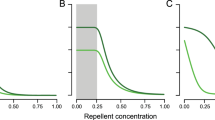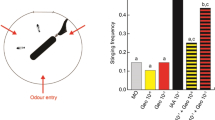Abstract
INTEREST in the possibility of using behaviour-inducing chemicals to assist in the control of insect pests has stimulated efforts to isolate, identify and synthesize insect pheromones and food and oviposition attractants. Identification of these substances is usually difficult because of the low concentration of biologically active material in the insect or plant source. Usually fractionation of a crude extract followed by behavioural bioassay of each fraction is the procedure. Shortage of time and material often makes it difficult to give each fraction an adequate behavioural examination, especially if synergism is suspected. To overcome this difficulty we have developed a technique whereby all the olfactory stimulating compounds in an extract can be quickly detected. The method is based on the general assumption that the principal receptors used in insect olfactory communication are those on the antenna1. It entails linking a gas chromatograph with the insect's antennal sense organs prepared for the recording of electroantennograms (EAGs). The volatile constituents of the test material are separated on the chromatographic column and the effluent is split between a flame ionization detector and the antenna. Simultaneous recording of gas chromatographic detector and insect responses makes possible the correlation of retention times with EAG responses.
This is a preview of subscription content, access via your institution
Access options
Subscribe to this journal
Receive 51 print issues and online access
$199.00 per year
only $3.90 per issue
Buy this article
- Purchase on Springer Link
- Instant access to full article PDF
Prices may be subject to local taxes which are calculated during checkout
Similar content being viewed by others
References
Von Frisch, K., Zool. Jahrb. Abt. Allg. Zool. und Physiol., 38, 449 (1921).
Tunstall, J. P., Pest Articles and News Summaries, A, 11, 212 (1965).
Schneider, D., Z. Vergl. Physiol., 40, 8 (1957).
Gaston, L. K., Fulento, T. R., and Shorey, H. H., Ann. Entomol. Soc. Amer., 59, 1062 (1966).
Wright, R. H., Nature, 204, 121 (1964).
Wood, D. L., Stark, R. W., Silverstein, R. M., and Rodin, J. O., Nature, 215, 206 (1967).
Jones, W. A., and Jacobson, M., Science, 159, 99 (1968).
Author information
Authors and Affiliations
Rights and permissions
About this article
Cite this article
MOORHOUSE, J., YEADON, R., BEEVOR, P. et al. Method for Use in Studies of Insect Chemical Communication. Nature 223, 1174–1175 (1969). https://doi.org/10.1038/2231174a0
Received:
Revised:
Issue Date:
DOI: https://doi.org/10.1038/2231174a0
This article is cited by
-
Non-targeted metabolomics aids in sex pheromone identification: a proof-of-concept study with the triangulate cobweb spider, Steatoda triangulosa
Scientific Reports (2023)
-
Light-Weight Portable Electroantennography Device as a Future Field-Based Tool for Applied Chemical Ecology
Journal of Chemical Ecology (2020)
-
Increasing Signal-to-Noise Ratio in Gas Chromatography - Electroantennography Using a Deans Switch Effluent Chopper
Journal of Chemical Ecology (2018)
-
Chopper-modulated gas chromatography electroantennography enabled using high-temperature MEMS flow control device
Microsystems & Nanoengineering (2017)
-
10.1007/BF00343454
CrossRef Listing of Deleted DOIs (2011)
Comments
By submitting a comment you agree to abide by our Terms and Community Guidelines. If you find something abusive or that does not comply with our terms or guidelines please flag it as inappropriate.



